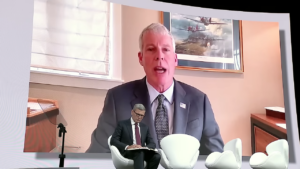Queensland regional utility Ergon Energy has begun the process of establishing an electric vehicle “super highway” on its network, with plans to install as many as 60 charging stations from Toowoomba to Cairns, for use by its own fleet of EVs as well as privately owned cars.
After announcing in July that its retail business was working with government and industry to help create an electric vehicle highway, with Australia’s first solar-powered fast-charging station for EVs to be established in Townsville, Ergon revealed last month that it had mapped its network for EV charging stations, identifying around 100 suitable sites with surplus network capacity (see image below).

The utility, which operates one of the largest networks in the world – said the mapping would also help identify the most valuable locations to invest in renewable energy and demand management within the national grid.
For the EV super-highway, however, Ergon said it was already in discussions with a number of charging station infrastructure companies, with plans to purchase up to 60 charging stations.
Local Queensland outfit Tritium, which manufactures the industry-leading Veefil fast-charger, is highly likely to be among the companies Ergon is talking to. The Brisbane-based firm was recently announced as the first beneficiary of the Queensland government’s $40 million Business Development Fund, with an investment of $2.5 million towards producing an even higher power Veefil unit, that can give EVs as much as 150km of range per 10 minutes of charge.
But slow uptake of electric vehicles in Australia has so far meant that the bulk of Tritium’s business has been in the export market.
Initiatives like Ergon’s, however, could help accelerate EV uptake by reducing concerns of range anxiety among potential EV buyers. The utility, meanwhile, is walking the talk, with an EV lease offer to employees.
“As the EV market develops in the eastern seaboard capital cities, we believe it will develop in regional Queensland cities from Toowoomba to Cairns and with it the need for public and private charging infrastructure,” said Ergon senior network strategy and policy engineer Don McPhail, in a statement.
McPhail said the Ergon team had “meticulously drilled right down” to individual suburban transformers to identify locations with surplus electricity capacity, in the knowledge that the EV market and the need charging points was going to grow.
“That will translate into an increase in the demand for power,” he said. “So we’d rather better utilise our existing assets as potential EV charging point sites rather than upgrade the network at considerable cost which puts upward pressure on electricity prices.
“In mapping our network, we also considered the driving range of fast charge capable vehicles like Teslas. We’ve identified how far apart the charging stations need to be along the Bruce Highway so drivers could get from one to the next and that they overlap.”
McPhail said that based on a driving range of about 400km and network mapping, Ergon had found it would be possible to have charging stations along the Bruce Highway at the major coastal communities all the way to Cairns.
“On that basis we’re already talking with industry and state government parties about potential EV charging sites or locations that have surplus network capacity. Our aim is also to lower the cost for them to connect to our network and these sites might just do that,” he said.
Tesla is also expanding its charging network in Australia with plans to extend it north to Brisbane from Sydney.










